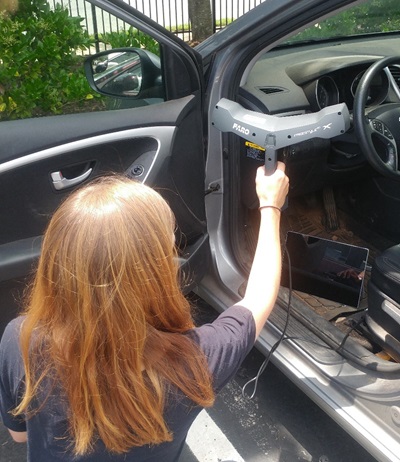The Crash Injury Research and Engineering Network (CIREN), under the National Highway Traffic Safety Administration (NHTSA) (part of the U.S. Department of Transportation), was formed to conduct motor vehicle crash investigations and to conduct research to improve the prevention, treatment and rehabilitation of motor vehicle crash injuries to reduce deaths, disabilities and human and economic costs.
Collecting and Studying Data
CIREN collects unidentified data from patient records, vehicles and crash locations to conduct research. Our crash investigator gathers pertinent information from the crash scene and the involved vehicle, including measurements, photographs and in-depth detail needed to reconstruct the collision. The CIREN team then gathers specific medical record and injury data associated with the crash, which assists in determining vehicle dynamics, occupant kinematics and crash scenarios that led to the patient’s injuries.

Identified injuries are sourced to contact points within the vehicle and coded into a research database that describes the mechanism of each injury. This data may be used for studying vehicle safety and occupant injuries in more thorough detail.
The CIREN team includes:
- Biomedical engineers
- Trauma surgeons, radiologists and other healthcare professionals
- Crash investigator
- Research personnel
Case Inclusion Criteria
To be enrolled as a CIREN case subject, the following criteria must be met:
- The vehicle model year must be within six years of the current model year
- At least one (1) AIS 3+ injury or two (2) AIS 2 injuries (with medical significance) in two different AIS body regions, or at least one (1) AIS 2 injury code of a specified type. Inclusion criteria may also include an AIS 2 concussive injury code if specific conditions are also met, as well as a Thoracolumbar Spine (TLS) – AIS 2+ vertebral body fracture in the T10-L5 region.
Exclusions and Exceptions
Collisions involving wheelchair-seated occupants who were using adaptive restraint equipment may qualify as case subjects with a vehicle model year as old as 1998, depending on the collision type. Patients in a child-restraint system can be enrolled with a vehicle model year older than six years, depending on the collision type.
Excluded CIREN cases include catastrophic impacts which result in greater than 50 percent compartment intrusion, nonadmitted fatal occupants lacking radiology or complete internal autopsy documentation, and case vehicles experiencing fire damage to the relevant portion of the occupant compartment.
CIREN Engineering and Medical Centers
The CIREN program is compiled of medical centers and engineering centers at seven different locations across the country. The medical centers collect cases and compile data for the national database. The engineering centers will perform reviews of medical center cases to ensure accurate biomechanical engineering analysis for injury causation determination. Both types of centers collaborate on discussions leading to final consensuses for database input.
CIREN Centers
- Emory University, Medical and Engineering Center
- Inova Fairfax Hospital, Medical Center
- Medical College of Wisconsin, Engineering Center
- University of Alabama at Birmingham, Medical Center
- University of Maryland - Baltimore, Medical Center
- University of Virginia, Engineering Center
- Wake Forest University/Virginia Tech, Medical and Engineering Center
